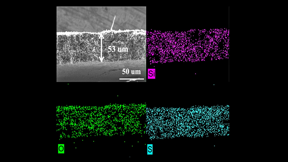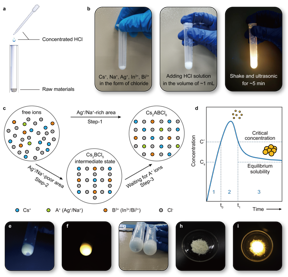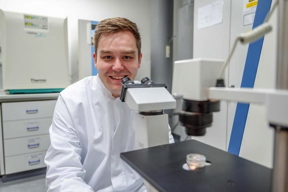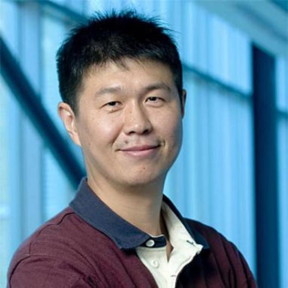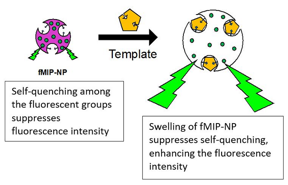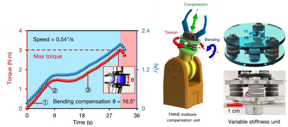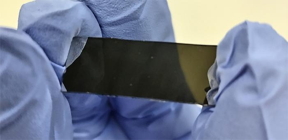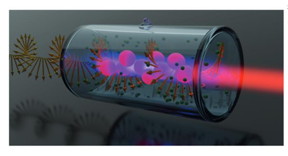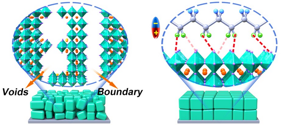Home > Press > New nanowire sensors are the next step in the Internet of Things
Abstract:
A new miniscule nitrogen dioxide sensor could help protect the environment from vehicle pollutants that cause lung disease and acid rain.
New nanowire sensors are the next step in the Internet of Things
Canberra, Australia | Posted on January 6th, 2023Researchers from TMOS, the Australian Research Council Centre of Excellence for Transformative Meta-Optical Systems have developed a sensor made from an array of nanowires, in a square one fifth of a millimetre per side, which means it could be easily incorporated into a silicon chip.
In research published in the latest issue of Advanced Materials, PhD scholar at the Centre’s Australian National University team and lead author Shiyu Wei describes the sensor as requiring no power source, as it runs on its own solar powered generator.
Wei says, “As we integrate devices like this into the sensor network for the Internet of Things technology, having low power consumption is a huge benefit in terms of system size and costs. The sensor could be installed in your car with an alarm sounding and alerts sent to your phone if it detects dangerous levels of nitrogen dioxide emitted from the exhaust.”
Co-lead author Dr. Zhe Li says “This device is just the beginning. It could also be adapted to detect other gases, such as acetone, which could be used as a non-invasive breath test of ketosis including diabetic ketosis, which could save countless lives.
Existing gas detectors are bulky and slow, and require a trained operator. In contrast, the new device can quickly and easily measure less than 1 part per billion, and the TMOS prototype used a USB interface to connect to a computer.
Nitrogen dioxide is one of the NOx category of pollutants. As well as contributing to acid rain, it is dangerous to humans even in small concentrations. It is a common pollutant from cars, and also is created indoors by gas stoves.
The key to the device is a PN junction – the engine of a solar cell – in the shape of a nanowire (a small hexagonal pillar with diameter about 100 nanometres, height 3 to 4 microns) sitting on a base. An ordered array of thousands of nanowire solar cells, spaced about 600 nanometres apart formed the sensor.
The whole device was made from indium phosphide, with the base doped with zinc to form the P part, and the N section at the tip of the nanowires, doped with silicon. The middle part of each nanowire was undoped (the intrinsic section, I) separating the P and N sections.
Light falling on the device causes a small current to flow between the N and P sections. However, if the intrinsic middle section of the PN junction is touched by any nitrogen dioxide, which is a strong oxidiser that sucks away electrons, this will cause a dip in the current.
The size of the dip allows the concentration of the nitrogen dioxide in the air to be calculated. Numerical modelling by Dr Zhe Li, a postdoctoral fellow in EME, showed that the PN junction’s design and fabrication are crucial to maximising the signal.
The characteristics of nitrogen dioxide – strong adsorption, strong oxidisation – make it easy for indium phosphide to distinguish it from other gases. The sensor could also be optimised to detect other gases by functionalising the indium phosphide nanowire surface.
TMOS Chief Investigator Professor Lan Fu, leader of the research group says “The ultimate aim is to sense multiple gases on the one small chip. As well as environmental pollutants, these sensors could be deployed for healthcare, for example, for breath tests for biomarkers of disease.
“The tiny gas sensor is easily integratable and scalable. This, combined with meta-optics, promises to achieve multiplexing sensors with high performance and multiple functionalities, which will enable them to fit into smart sensing networks. TMOS is a network of research groups across Australia dedicated to progressing this field.
“The technologies we develop will transform our life and society in the coming years, with large‐scale implementation of Internet of Things technology for real‐time data collection and autonomous response in applications such as air pollution monitoring, industrial chemical hazard detection, smart cities, and personal healthcare.”
####
For more information, please click here
Contacts:
Media Contact
Samara Thorn
ARC Centre of Excellence for Transformative Meta-Optical Systems
Cell: 421276272
Expert Contacts
Lan Fu
TMOS, Research School of Physics, Australian National University
@tmos_arc
Shiyu Wei
TMOS, Research School of Physics, Australian National University
@TMOS, Research School of Physics, Australian National University
Copyright © ARC Centre of Excellence for Transformative Meta-Optical Systems
If you have a comment, please Contact us.Issuers of news releases, not 7th Wave, Inc. or Nanotechnology Now, are solely responsible for the accuracy of the content.
| Related Links |
| Related News Press |
News and information
![]() Electricity harvesting from evaporation, raindrops and moisture inspired by nature January 6th, 2023
Electricity harvesting from evaporation, raindrops and moisture inspired by nature January 6th, 2023
![]() Lithium-sulfur batteries are one step closer to powering the future January 6th, 2023
Lithium-sulfur batteries are one step closer to powering the future January 6th, 2023
![]() Wafer-scale 2D MoTe₂ layers enable highly-sensitive broadband integrated infrared detector January 6th, 2023
Wafer-scale 2D MoTe₂ layers enable highly-sensitive broadband integrated infrared detector January 6th, 2023
Internet-of-Things
![]() New chip ramps up AI computing efficiency August 19th, 2022
New chip ramps up AI computing efficiency August 19th, 2022
![]() Lightening up the nanoscale long-wavelength optoelectronics May 13th, 2022
Lightening up the nanoscale long-wavelength optoelectronics May 13th, 2022
![]() Thin-film, high-frequency antenna array offers new flexibility for wireless communications November 5th, 2021
Thin-film, high-frequency antenna array offers new flexibility for wireless communications November 5th, 2021
![]() MXene-GaN van der Waals metal-semiconductor junctions for high performance photodetection September 24th, 2021
MXene-GaN van der Waals metal-semiconductor junctions for high performance photodetection September 24th, 2021
Possible Futures
![]() Development of bio-friendly transparent temperature sensor technology that precisely measures temperature changes by light January 6th, 2023
Development of bio-friendly transparent temperature sensor technology that precisely measures temperature changes by light January 6th, 2023
![]() Dual-site collaboration boosts electrochemical nitrogen reduction on Ru-S-C single-atom catalyst January 6th, 2023
Dual-site collaboration boosts electrochemical nitrogen reduction on Ru-S-C single-atom catalyst January 6th, 2023
Sensors
![]() Development of bio-friendly transparent temperature sensor technology that precisely measures temperature changes by light January 6th, 2023
Development of bio-friendly transparent temperature sensor technology that precisely measures temperature changes by light January 6th, 2023
![]() Wafer-scale 2D MoTe₂ layers enable highly-sensitive broadband integrated infrared detector January 6th, 2023
Wafer-scale 2D MoTe₂ layers enable highly-sensitive broadband integrated infrared detector January 6th, 2023
![]() Tin selenide nanosheets enables to develop wearable tracking devices December 9th, 2022
Tin selenide nanosheets enables to develop wearable tracking devices December 9th, 2022
Discoveries
![]() Electricity harvesting from evaporation, raindrops and moisture inspired by nature January 6th, 2023
Electricity harvesting from evaporation, raindrops and moisture inspired by nature January 6th, 2023
![]() Lithium-sulfur batteries are one step closer to powering the future January 6th, 2023
Lithium-sulfur batteries are one step closer to powering the future January 6th, 2023
![]() Wafer-scale 2D MoTe₂ layers enable highly-sensitive broadband integrated infrared detector January 6th, 2023
Wafer-scale 2D MoTe₂ layers enable highly-sensitive broadband integrated infrared detector January 6th, 2023
Announcements
![]() Electricity harvesting from evaporation, raindrops and moisture inspired by nature January 6th, 2023
Electricity harvesting from evaporation, raindrops and moisture inspired by nature January 6th, 2023
![]() Lithium-sulfur batteries are one step closer to powering the future January 6th, 2023
Lithium-sulfur batteries are one step closer to powering the future January 6th, 2023
![]() Wafer-scale 2D MoTe₂ layers enable highly-sensitive broadband integrated infrared detector January 6th, 2023
Wafer-scale 2D MoTe₂ layers enable highly-sensitive broadband integrated infrared detector January 6th, 2023
Interviews/Book Reviews/Essays/Reports/Podcasts/Journals/White papers/Posters
![]() Electricity harvesting from evaporation, raindrops and moisture inspired by nature January 6th, 2023
Electricity harvesting from evaporation, raindrops and moisture inspired by nature January 6th, 2023
![]() Lithium-sulfur batteries are one step closer to powering the future January 6th, 2023
Lithium-sulfur batteries are one step closer to powering the future January 6th, 2023
![]() Wafer-scale 2D MoTe₂ layers enable highly-sensitive broadband integrated infrared detector January 6th, 2023
Wafer-scale 2D MoTe₂ layers enable highly-sensitive broadband integrated infrared detector January 6th, 2023
Environment
![]() New method of reducing carbon dioxide could be a golden solution to pollution December 9th, 2022
New method of reducing carbon dioxide could be a golden solution to pollution December 9th, 2022
![]() Scientists have proposed a new material for perovskite solar cells: It is cheaper its analogues, easier to manufacture and to modify October 28th, 2022
Scientists have proposed a new material for perovskite solar cells: It is cheaper its analogues, easier to manufacture and to modify October 28th, 2022
Automotive/Transportation
![]() The battery that runs 630 km on a single charge October 7th, 2022
The battery that runs 630 km on a single charge October 7th, 2022
- SEO Powered Content & PR Distribution. Get Amplified Today.
- Platoblockchain. Web3 Metaverse Intelligence. Knowledge Amplified. Access Here.
- Source: http://www.nanotech-now.com/news.cgi?story_id=57265
- 1
- 10
- 100
- 2D
- a
- About
- accuracy
- Achieve
- across
- adapted
- advanced
- Advanced materials
- AI
- aids
- AIR
- Air pollution
- alarm
- allows
- and
- antenna
- apart
- applicable
- applications
- Arc
- architecture
- areas
- Array
- AUGUST
- Australia
- Australian
- author
- autonomous
- base
- batteries
- battery
- Beginning
- benefit
- between
- Billion
- Breath
- broadband
- calculated
- car
- carbon
- carbon dioxide
- cars
- Catalyst
- catalysts
- Category
- Cause
- causes
- Cells
- Center
- centre
- CGI
- Changes
- characteristics
- charge
- charges
- cheaper
- chemical
- chief
- chip
- Cities
- closer
- collaboration
- collection
- COM
- combined
- coming
- comment
- Common
- computer
- computing
- concentration
- Connect
- consumption
- content
- contrast
- contributing
- Costs
- could
- Council
- created
- crucial
- Current
- Dangerous
- data
- December
- dedicated
- demonstrated
- deployed
- Design
- Detection
- develop
- developed
- device
- Devices
- Dip
- discovery
- Disease
- distinguish
- diverse
- down
- each
- easier
- easily
- Electric
- electrons
- emission
- enable
- enables
- energy
- Engine
- engineer
- Environment
- environmental
- Ether (ETH)
- Even
- example
- Excellence
- explore
- Falling
- fellow
- field
- First
- fit
- Flexibility
- flow
- form
- formed
- friction
- frictionless
- from
- functionalities
- fundamental
- future
- GAS
- generator
- gif
- Golden
- Group
- Group’s
- Harvesting
- having
- healthcare
- height
- help
- High
- High-Frequency
- highly
- holography
- However
- HTTPS
- huge
- Humans
- implementation
- important
- improvement
- in
- Inc.
- Including
- Incorporated
- independent
- industrial
- information
- inspired
- integrate
- integrated
- Interface
- Internet
- internet of things
- intrinsic
- issue
- IT
- January
- just one
- Key
- lab
- large-scale
- latest
- Law
- layers
- lead
- leader
- Leads
- levels
- Life
- Life Sciences
- links
- Lives
- Low
- made
- make
- map
- material
- materials
- maximising
- means
- measure
- measures
- method
- Middle
- million
- modelling
- monitoring
- more
- multiple
- nanotechnology
- National
- net
- network
- networks
- New
- news
- next
- novel
- November
- nox
- october
- Offers
- ONE
- operator
- Optimised
- optimizing
- Other
- own
- part
- performance
- personal
- phone
- PHP
- Physics
- Pillar
- Plasma
- platinum
- plato
- Plato Data Intelligence
- PlatoData
- please
- Pollution
- Post
- posted
- potential
- power
- powered
- Powering
- precisely
- Precision
- Prepare
- Professor
- progressing
- project
- promises
- properties
- proposed
- protect
- Proteins
- prototype
- providing
- published
- Quantum
- quantum computing
- Quantum dots
- quantum networks
- quickly
- RAIN
- Ramps
- range
- reducing
- Releases
- Renewable
- renewable energy
- require
- research
- research group
- researchers
- response
- responsible
- return
- Reveals
- Save
- scalable
- School
- Science
- SCIENCES
- scientists
- Search
- Section
- sections
- semiconductor
- sense
- Sensitivity
- sensors
- separating
- September
- Shape
- Share
- Signal
- Silicon
- single
- Sitting
- Size
- slow
- small
- smart
- Smart Cities
- Society
- solar
- Solar cells
- solution
- Source
- Spark
- square
- start
- Step
- strong
- submit
- such
- Surface
- system
- Systems
- team
- Technologies
- Technology
- terms
- test
- tests
- The
- things
- thousands
- tip
- to
- toward
- Tracking
- trained
- Transform
- transformative
- transparent
- ultimate
- unconventional
- university
- us
- usb
- use
- vehicle
- Wave
- wearable
- which
- will
- wireless
- Work
- Yahoo
- years
- Your
- zephyrnet










